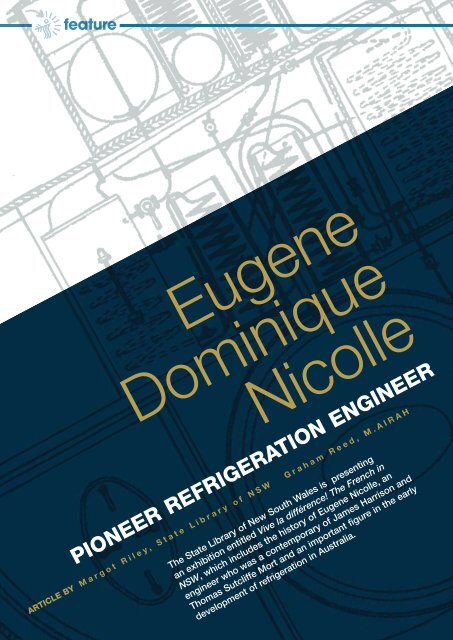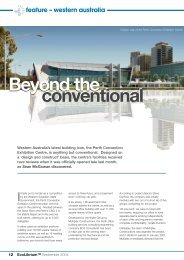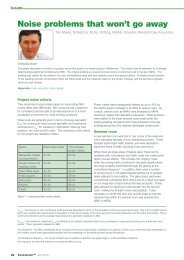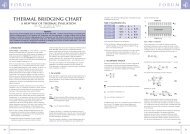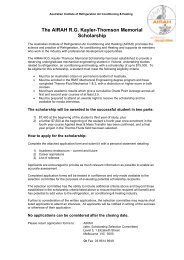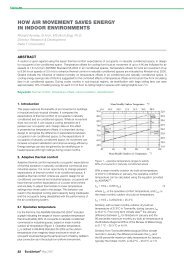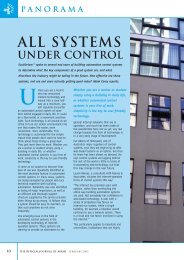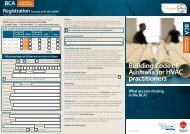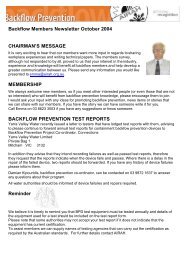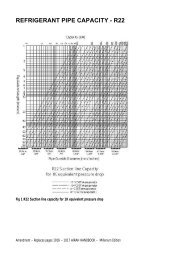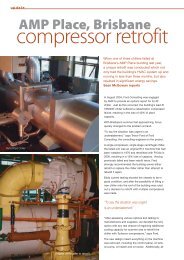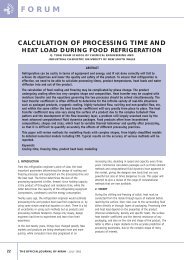full article - Australian Institute of Refrigeration Air Conditioning and ...
full article - Australian Institute of Refrigeration Air Conditioning and ...
full article - Australian Institute of Refrigeration Air Conditioning and ...
Create successful ePaper yourself
Turn your PDF publications into a flip-book with our unique Google optimized e-Paper software.
feature<br />
ARTICLE BY M a r g o t R i l e y , S t a t e L i b r a r y o f N S W G r a h a m R e e d , M . A I R A H<br />
8 EcoLibrium September 2004<br />
Eugene<br />
Dominique<br />
Nicolle<br />
PIONEER REFRIGERATION ENGINEER<br />
The State Library <strong>of</strong> New South Wales is presenting<br />
an exhibition entitled Vive la différence! The French in<br />
NSW, which includes the history <strong>of</strong> Eugene Nicolle, an<br />
engineer who was a contemporary <strong>of</strong> James Harrison <strong>and</strong><br />
Thomas Sutcliffe Mort <strong>and</strong> an important figure in the early<br />
development <strong>of</strong> refrigeration in Australia.
Figure 1 - Nicolle <strong>and</strong> Mort’s patent<br />
revolving freezer c. 1874 – NSW Patent<br />
429 (ink drawing on paper, State Library<br />
<strong>of</strong> NSW)<br />
The Vive la difference exhibition includes<br />
a design by Eugene Nicolle for an ice<br />
making machine (Figure 1) that used<br />
ammonia to chill a metal cylinder which<br />
revolved in a bath <strong>of</strong> cold water, causing<br />
ice to form on the outside <strong>of</strong> the cylinder.<br />
The ice was then scraped <strong>of</strong>f, dropping<br />
down a chute to be compressed by<br />
hydraulic rams into ice blocks.<br />
Born in 1823 in Rouen, France, Eugene<br />
Nicolle arrived in Sydney in 1853 <strong>and</strong><br />
started work as an engineer soon<br />
afterwards. He later became manager for<br />
P N Russell <strong>and</strong> Son, where he remained<br />
for several years before leaving to set up<br />
his own business at Circular Quay. He<br />
designed <strong>and</strong> supervised the erection<br />
<strong>of</strong> the sawmills for Wilkinson <strong>and</strong> Co.,<br />
<strong>and</strong> installed the colony’s first vertical<br />
saw system. At times long distances<br />
had to be travelled in connection with<br />
the erection <strong>of</strong> milling <strong>and</strong> brewery<br />
machinery.<br />
In late 1859, Nicolle decided to construct<br />
an ice making machine based on a<br />
process using the compression <strong>of</strong><br />
ether that had been invented by James<br />
Harrison. The Sydney Ice Company had<br />
been formed by P N Russell & Co.<br />
<strong>and</strong> James Harrison <strong>and</strong> as Nicolle<br />
had shares in P N Russell, he put<br />
aside his lucrative saw milling<br />
<strong>and</strong> brewery work to become<br />
involved in the newly-formed<br />
company.<br />
In those early days natural ice,<br />
cut from rivers <strong>and</strong> lakes, was<br />
imported from America, <strong>and</strong><br />
stored at Circular Quay. But<br />
the waste <strong>and</strong> losses <strong>of</strong> this trade<br />
were so unsatisfactory that they<br />
spurred Nicolle to further efforts in the<br />
manufacture <strong>of</strong> ice himself.<br />
At first his efforts were to refine the<br />
Harrison process but in 1861 he<br />
registered a patent, jointly with Richard<br />
Dawson, for an ice making machine.<br />
Freezing works were erected at<br />
Darlinghurst, <strong>and</strong> there for several years<br />
Nicolle carried on the manufacture <strong>of</strong><br />
ice by a new process for which he took<br />
out patent rights. This process was the<br />
liquidation by pressure <strong>of</strong> ammonia gas.<br />
No mechanism was required, or motive<br />
power, the process being purely a<br />
chemical one <strong>and</strong> capable <strong>of</strong> producing<br />
a low temperature <strong>of</strong> -56ºC.<br />
It was in 1863 that Nicolle took out<br />
the first patent for ice-making, <strong>and</strong> not<br />
only was he able to stop the American<br />
importations, but supplied the northern<br />
ports <strong>of</strong> Queensl<strong>and</strong> as well.<br />
The following year he <strong>and</strong> Dawson,<br />
together with the Wilkinson brothers,<br />
who had previously employed him,<br />
bought the Sydney Ice Company<br />
(subsequently renamed the NSW Ice<br />
Company) <strong>and</strong> in 1863 they began to<br />
produce ice with Nicolle’s machine.<br />
Nicolle <strong>and</strong> his partners designed <strong>and</strong><br />
built a variety <strong>of</strong> cooling apparatus<br />
<strong>and</strong> success<strong>full</strong>y applied them to both<br />
domestic <strong>and</strong> industrial use, such<br />
as making powdered milk, the first<br />
refrigerated meat works in Darling<br />
Harbour, as well as the refrigeration<br />
<strong>of</strong> railway vans for meat <strong>and</strong> milk.<br />
They convincingly demonstrated that<br />
it was both possible <strong>and</strong> safe to<br />
freeze food for long periods <strong>and</strong><br />
then thaw it for human consumption.<br />
Nicolle’s techniques included ammonia<br />
absorption, air expansion, low pressure<br />
ammonia absorption <strong>and</strong> ammonia<br />
reabsorption.<br />
Figure 2 – gold medal awarded to Nicolle<br />
<strong>and</strong> Mort in 1874 by the Agricultural<br />
Society <strong>of</strong> New South Wales for their<br />
refrigeration machine (State Library<br />
<strong>of</strong> NSW)<br />
feature<br />
The one challenge that eluded Nicolle<br />
throughout his career was the design<br />
<strong>and</strong> manufacture <strong>of</strong> special refrigerating<br />
machinery for shipping meat overseas.<br />
In the mid-1860s he began work on this<br />
project with an enthusiastic new partner,<br />
Augustus Morris, who had large pastoral<br />
interests. Morris introduced Nicolle to<br />
Thomas Sutcliffe Mort, who <strong>of</strong>fered to<br />
find the capital if Nicolle contributed<br />
the skill. Mort had read about a frozen<br />
mammoth being found in Siberia, making<br />
him think that frozen meat was the only<br />
answer for long haulage transportation<br />
<strong>and</strong> that the frozen conditions must<br />
be maintained on ship for a minimum<br />
<strong>of</strong> three months to deliver the cargo to<br />
markets in Europe.<br />
Nicolle designed a machine able to<br />
store <strong>and</strong> freeze some 40 tons <strong>of</strong> meat<br />
in 1867. A trial <strong>of</strong> the apparatus was<br />
conducted lasting over 12 months <strong>and</strong><br />
was very satisfactory. Always with<br />
the future in view, this apparatus was<br />
designed to suit shipboard use <strong>and</strong> it<br />
was in connection with this that the<br />
partners met their first rebuff.<br />
At that time ships rarely exceeded 600<br />
tons, <strong>and</strong> shipmasters were unwilling to<br />
alter the internal construction for fear <strong>of</strong><br />
weakening their vessels. Exception was<br />
also taken to the circulation <strong>of</strong> ammonia<br />
gas at high pressure that might escape<br />
in heavy weather, <strong>and</strong> perhaps damage<br />
the rest <strong>of</strong> the cargo.<br />
To get over this difficulty a second<br />
apparatus was constructed on the lowpressure<br />
basis, capable <strong>of</strong> freezing half<br />
a ton <strong>of</strong> water daily, <strong>and</strong> still maintaining<br />
an even temperature. A freezingchamber<br />
was erected at the rear <strong>of</strong> the<br />
Royal Hotel, George Street (on the site<br />
<strong>of</strong> the Dymocks Building) <strong>and</strong> was<br />
in operation for some 15 months,<br />
during which time thous<strong>and</strong>s<br />
<strong>of</strong> people visited the place <strong>and</strong><br />
witnessed the experiments being<br />
carried out.<br />
It was at this stage that Mort<br />
decided something more ambitious<br />
should be attempted. Large freezing<br />
works were erected at Darling<br />
Harbour under Nicolle’s supervision<br />
<strong>and</strong> designs. An attempt was made to<br />
fit up the Whampoa, a large steamer,<br />
which seemed to possess the necessary<br />
space. Negotiations were entered into,<br />
backed up by Captain Farquhar, a retired<br />
P & O comm<strong>and</strong>er who at the time was<br />
the manager <strong>of</strong> the F F <strong>and</strong> I Company.<br />
The proposal was vetoed, however,<br />
EcoLibrium September 2004 9
feature<br />
Figure 3 – Eugene<br />
Dominique Nicolle<br />
by the captain <strong>of</strong> the vessel on learning<br />
that liquefied ammonia was the freezing<br />
agent.<br />
Nicolle <strong>and</strong> Mort were mortified at the<br />
captain’s refusal, but recognised that<br />
either a high or low pressure ammonia<br />
apparatus would be against insurance<br />
regulations. Therefore, they turned their<br />
attention to the compressed air system<br />
but this was discarded for another<br />
ammonia plant. The next attempt,<br />
in 1877, was to fit up the Northam,<br />
an iron sailing vessel, for which they<br />
paid a heavy fee (demurrage) to hold<br />
the ship in port for three months whilst<br />
the refrigeration plant was installed <strong>and</strong><br />
commissioned.<br />
Originally, the ship was to sail in April but<br />
it was July before the plant was finally<br />
operating perfectly. The temperature <strong>of</strong><br />
the meat chamber was reduced to 2ºC<br />
in only sixty hours <strong>and</strong> thus all seemed<br />
ready to go. Alas, a few hours before<br />
the prepared frozen meat was to be<br />
loaded onto the ship, it was discovered<br />
that the ammonia had reacted with the<br />
iron <strong>of</strong> which some the components<br />
were made.<br />
Repairs would have taken another three<br />
weeks. The heavy demurrage <strong>and</strong><br />
outraged protests from the captain <strong>and</strong><br />
other shipping agents caused Mort to<br />
reluctantly allow the Northam to sail<br />
without the meat on board but with<br />
the machinery <strong>and</strong> engineering staff to<br />
affect repairs <strong>and</strong> test the equipment<br />
on the voyage. These men, returning<br />
from Engl<strong>and</strong> on a mail boat, proved by<br />
records taken that the apparatus had<br />
performed its work satisfactorily.<br />
In 1878, two unfortunate incidents<br />
occurred: the death <strong>of</strong> Mort, aged 61,<br />
About the authors<br />
Margot Riley is the curator <strong>of</strong> Vive la différence!, assisted by Emeritus Pr<strong>of</strong>essor Ivan Barko, former McCaughey<br />
Pr<strong>of</strong>essor <strong>of</strong> French at the University <strong>of</strong> Sydney. Graham Reed is currently involved in the upgrade <strong>of</strong> the HVAC<br />
systems at the State Library <strong>of</strong> NSW.<br />
The exhibition will be on show in the Picture Gallery <strong>of</strong> the State Library <strong>of</strong> NSW until 10 October 2004.<br />
10 EcoLibrium September 2004<br />
at his Bodalla estate; <strong>and</strong> the loss at sea<br />
<strong>of</strong> the Northam on her return voyage to<br />
Sydney with the refrigeration plant.<br />
Elsewhere, other trials were being carried<br />
out. In 1873, James Harrison<br />
<strong>of</strong> Geelong had sent <strong>of</strong>f an<br />
unsuccessful shipment from<br />
Melbourne to Engl<strong>and</strong> on the<br />
Norfolk. A shipment <strong>of</strong> frozen<br />
meat on the French vessel, La<br />
Frigorifique, sailing from Buenos<br />
<strong>Air</strong>es to Rouen arrived in August<br />
1877 success<strong>full</strong>y using the<br />
process built by the French<br />
engineer M. Tellier who had<br />
been experimenting for some<br />
ten years. The first successful<br />
shipment from Australia to<br />
Engl<strong>and</strong>, on the Strathleven,<br />
arrived in February 1880.<br />
Despite this, both Mort <strong>and</strong><br />
Nicolle should be rated highly as<br />
pioneers <strong>of</strong> refrigeration. Many<br />
minor features incorporated in<br />
refrigeration systems were first identified<br />
by Nicolle. Together Nicolle <strong>and</strong> Mort,<br />
from 1864 to 1876, were issued with<br />
twelve patents. Importantly, Mort’s<br />
vision, energy <strong>and</strong> determination made<br />
refrigeration transportation widely<br />
accepted in Australia. Indeed, by<br />
1937, some 60 years after the Northam<br />
experiment, the statistics for <strong>Australian</strong><br />
export <strong>of</strong> frozen (or chilled) products,<br />
show that some 2,300,000 tons <strong>of</strong> beef,<br />
over 1,900,000 tons <strong>of</strong> mutton/lamb <strong>and</strong><br />
1,700,000 tons <strong>of</strong> butter had been sent<br />
overseas.<br />
In July 1875, Nicolle sold his interest in<br />
the business <strong>and</strong> most <strong>of</strong> his patents<br />
(except for the revolving freezer) to Mort<br />
<strong>and</strong> associates who formed The NSW<br />
Fresh Food <strong>and</strong> Ice Company. Nicolle<br />
declined shares in this firm preferring<br />
to continue in a consulting capacity<br />
for another three years. After a trip to<br />
Europe in 1879 during which his wife,<br />
Jane Williamson, died, he retired to his<br />
300-acre property Whiteheath at Lake<br />
Illawarra, where he continued to tackle<br />
problems with the same dedication that<br />
characterised his pr<strong>of</strong>essional life.<br />
He kept himself abreast <strong>of</strong> the scientific<br />
times <strong>and</strong> had a keen interest in<br />
photography <strong>and</strong> medicine. Eugene<br />
Nicolle died in 1909 <strong>and</strong> was survived<br />
by a son, twin daughters <strong>and</strong> a<br />
stepdaughter.<br />
Figure 4 – section <strong>of</strong> ship fitted for cold storage<br />
(planned by Nicolle, 1867) - Selfe (1900)<br />
Bibliography<br />
<strong>Australian</strong> Dictionary <strong>of</strong> Biography, 1851-<br />
1890, vol 5. p. 342<br />
Barnard, A. (1961) Visions <strong>and</strong> Pr<strong>of</strong>its<br />
(Studies in the Business Career <strong>of</strong><br />
T.S.Mort) Melbourne University Press<br />
Ice & <strong>Refrigeration</strong>, Vol. 16, No. 1-6<br />
(April 1899), “A Pioneer <strong>Refrigeration</strong><br />
Engineer, by Norman Selfe”.<br />
Lang, W.R. (2003) James Harrison,<br />
pioneering genius. IMAG Digital Media<br />
Royal <strong>Australian</strong> Historical Society<br />
Journal <strong>and</strong> Proceedings, Vol. 24, Part 5,<br />
(1938) “Thomas Sutcliffe Mort: A National<br />
Benefactor” by James Jervis<br />
Royal <strong>Australian</strong> Historical Society<br />
Journal <strong>and</strong> Proceedings, Vol. 34, Part 5,<br />
(1948) “Notes on the Lives <strong>of</strong> Augustus<br />
Morris & Eugene Dominique Nicolle” by<br />
James Jervis<br />
Selfe, N. (1900) Machinery for<br />
<strong>Refrigeration</strong> H.S. Rich & Co. Chicago


